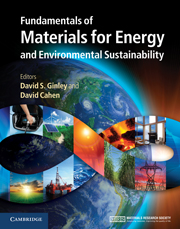Book contents
- Frontmatter
- Contents
- Contributors
- Preface
- Acknowledgments
- Part 1 Energy and the environment: the global landscape
- Part 2 Nonrenewable energy sources
- Part 3 Renewable energy sources
- Part 4 Transportation
- Part 5 Energy efficiency
- Part 6 Energy storage, high-penetration renewables, and grid stabilization
- Summary
- Appendix A Thermodynamics
- Appendix B Electrochemistry
- Appendix C Units
- Index
Preface
Published online by Cambridge University Press: 05 June 2012
- Frontmatter
- Contents
- Contributors
- Preface
- Acknowledgments
- Part 1 Energy and the environment: the global landscape
- Part 2 Nonrenewable energy sources
- Part 3 Renewable energy sources
- Part 4 Transportation
- Part 5 Energy efficiency
- Part 6 Energy storage, high-penetration renewables, and grid stabilization
- Summary
- Appendix A Thermodynamics
- Appendix B Electrochemistry
- Appendix C Units
- Index
Summary
Preface
Academically and industrially there is increasing awareness that energy and the environment present society with issues that are pressing and need to be approached globally. Many of the global effects are driven by two factors: the continuing increase in population as shown in Figure 1 from the IEA World Energy Outlook report for 2009 and the increasing demand for energy, both from the new developing and from the developed countries, as shown in Figure 2, which comes from the BP Energy Outlook 2030 Report page 8, published in January 2011, which summarizes global energy use over 60 years.
This growing global energy demand alone, independent of environmental concerns, is such a problem globally that innovative and creative solutions must be found to meet this demand. This is probably more challenging in the developing countries, where resource limitations may limit the number of options available, than in the developed ones. We note this, because as this text will emphasize, there is no obvious way to achieve this. In fact, it is clear that the demand will have to be met by a mosaic of current, as well as new, sources. Overall, the fact that a diversity of new energy sources is needed, will create new, large-scale industries, a development that may lead to significant changes in, or even the end of, some of our current established industries. If we now include the various environmental concerns that accompany modern society's functioning, this leads to the drive to achieve new energy-generating and -storage capacity via sustainable and clean technologies. At the same time, both these concerns, and the increasing energy demand, re-emphasize the need to accelerate the adoption of more efficient technologies worldwide. Underlying all of these changes is the basic understanding that the approaches that will be implemented must be ultimately sustainable not for tens or hundreds of years, but for thousands of years.
- Type
- Chapter
- Information
- Publisher: Cambridge University PressPrint publication year: 2011



